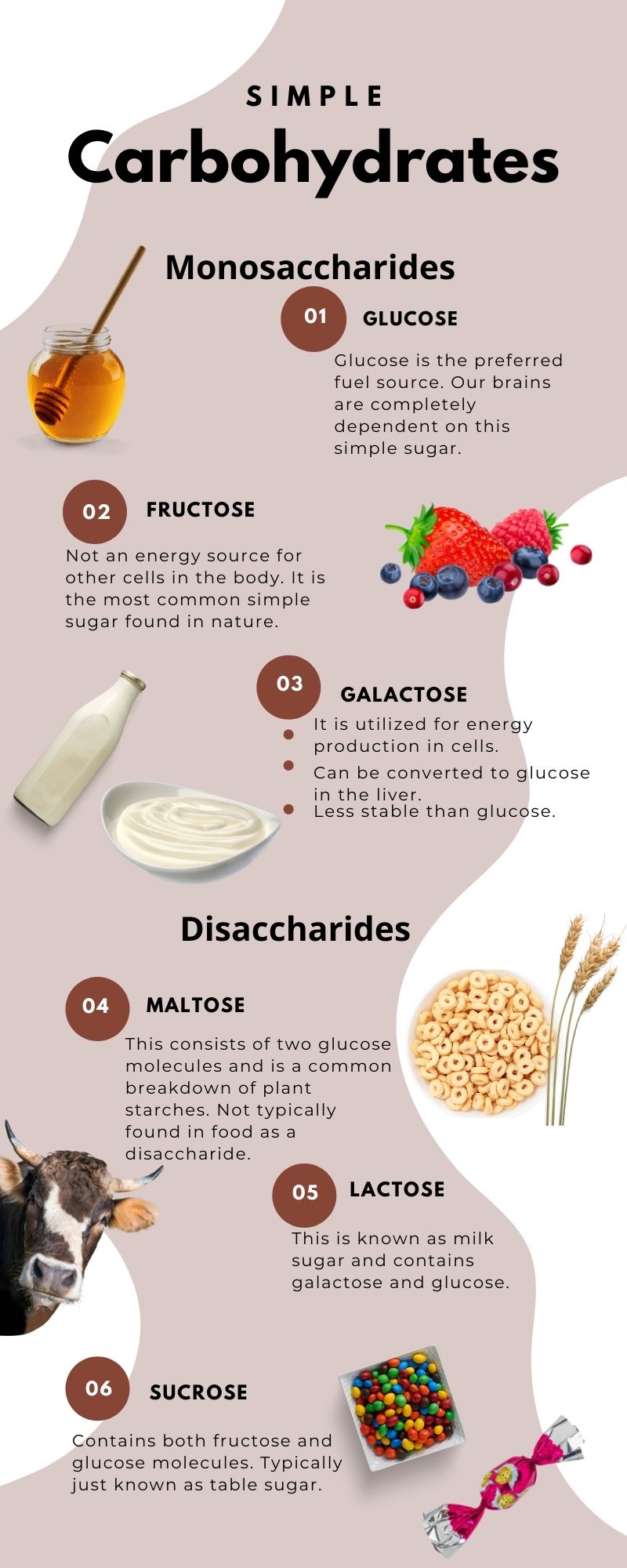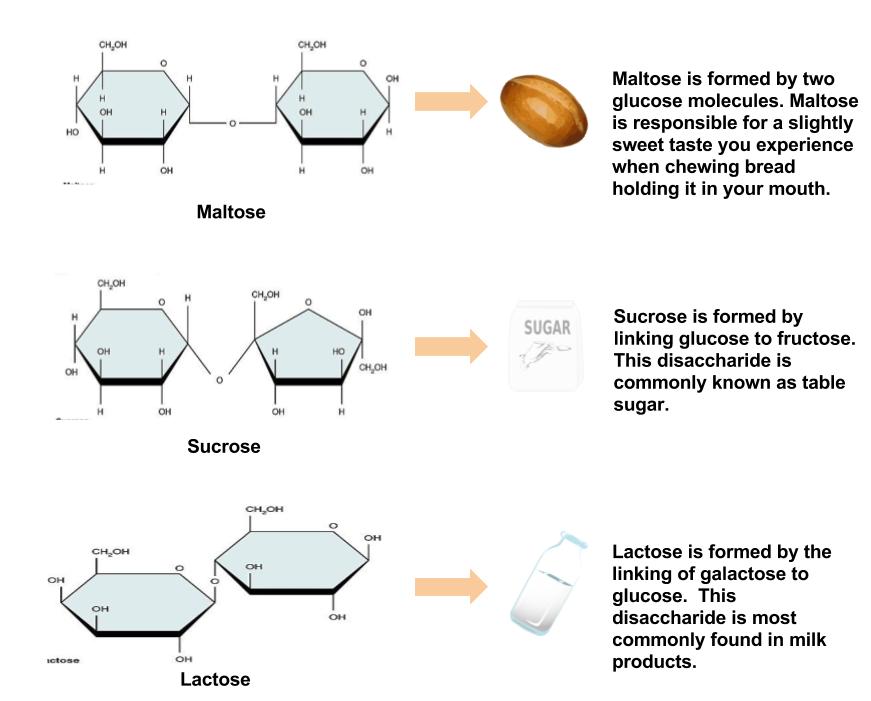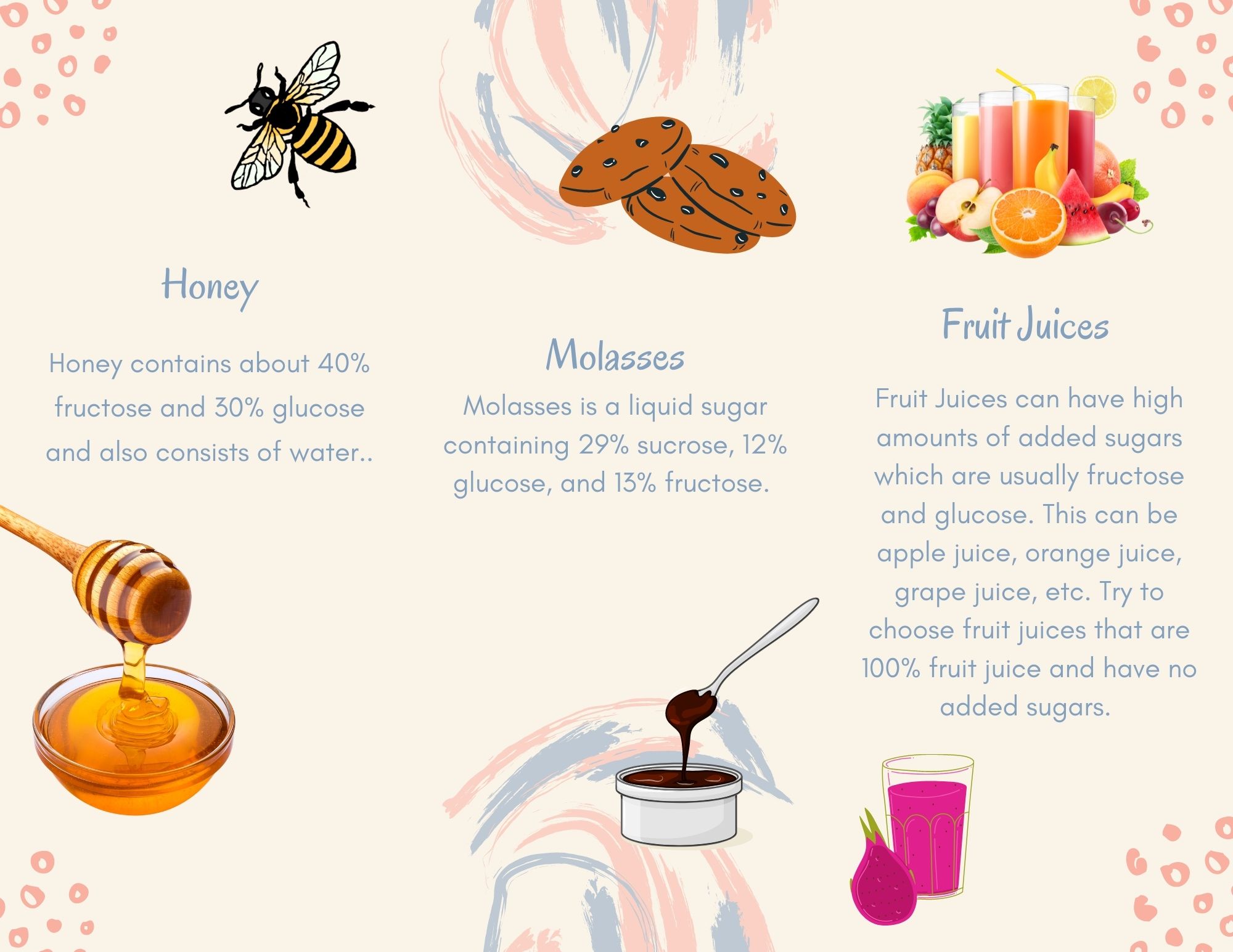5.2 Simple Carbohydrates
Simple carbohydrates are also known more simply as “sugars” and are grouped as either monosaccharides or disaccharides. The word monosaccharide comes from the root words “mono” meaning one and “saccharide” meaning sugar. Monosaccharides are one single sugar and include glucose, fructose, and galactose. The word disaccharide comes from the root words “di” meaning two and “saccharide” meaning sugar. Disaccharides are composed of two monosaccharides joined together. The most common disaccharides include lactose, maltose, and sucrose.
Simple carbohydrates stimulate the sweet taste sensation, which is the most sensitive of all taste sensations. Even extremely low concentrations of sugars in foods will stimulate the sweetness taste sensation. Sweetness varies between the different types of carbohydrate – some are much sweeter than others. Fructose is the top naturally-occurring sugar in sweetness value.
Figure 5.2 Simple Carbohydrates

Monosaccharides
For all organisms from bacteria to plants to animals, glucose is the preferred fuel source. The brain is completely dependent on glucose as its energy source (except during extreme starvation conditions). The monosaccharide galactose differs from glucose only in that a hydroxyl (−OH) group faces in a different direction on the number four carbon. This small structural alteration causes galactose to be less stable than glucose. As a result, the liver rapidly converts it to glucose. Most absorbed galactose is utilized for energy production in cells after its conversion to glucose. (Galactose is one of two simple sugars that are bound together to make up the sugar found in milk. It is later freed during the digestion process.) Fructose also has the same chemical formula as glucose but differs in its chemical structure, as the ring structure contains only five carbons and not six. Fructose, in contrast to glucose, is not an energy source for other cells in the body. However, after digestion and absorption, fructose is also converted to glucose in the liver and the glucose can be used for energy. Mostly found in fruits, honey, and sugarcane, fructose is one of the most common monosaccharides in nature. It is also found in soft drinks, cereals, and other products sweetened with high fructose corn syrup. Below, in Figure 5.3, you can see the chemical structures of the three monosaccharides. If you count the carbon, hydrogen, and oxygen molecules, you will see that each monosaccharide is composed of the same elements, they are just rearranged differently in each sugar molecule.
Figure 5.3 Structures of the Three Most Common Monosaccharides: Glucose, Galactose, and Fructose

Circles indicate the structural differences between the three.
Disaccharides
Disaccharides are composed of pairs of two monosaccharides linked together. Disaccharides include sucrose, lactose, and maltose. All of the disaccharides contain at least one glucose molecule.
Sucrose, which contains both glucose and fructose molecules, is otherwise known as table sugar. Sucrose is also found in many fruits and vegetables, and at high concentrations in sugar beets and sugarcane, which are used to make table sugar. Lactose, which is commonly known as milk sugar, is composed of one glucose unit and one galactose unit. Lactose is prevalent in dairy products such as milk, yogurt, and cheese. Maltose consists of two glucose molecules bonded together. It is a common breakdown product of plant starches and is rarely found in foods as a disaccharide. In Figure 5.4, you can see the chemical composition of the three most common disaccharides.
Figure 5.4 The Most Common Disaccharides

Chemically speaking, all sugar in your diet is processed the same by your body. Your body doesn’t care if the sucrose you are eating comes from organic maple syrup, honey, or GMO sugar cane. It just sees glucose and fructose. All of these sweeteners are considered added sugar because they have little to no micronutrients and are sources of empty calories. Sugar is also found in some foods that are considered nutrient dense. These sugars are called naturally occurring sugars and are found in fruits, milk, and some vegetables. When we tell healthy people to limit their sugar intake, added sugar is more of a concern than naturally occuring sugars. Now food labels differentiate between added and naturally occurring sugars so consumers can be more informed.
Added Sugar
Added sugars are considered empty calories and are the sugars that are added to foods after processing or during preparation. The 2020-25 Dietary Guidelines for Americans recommends that less than 10% of an individual’s calorie intake should come from added sugars (1). This means that someone following a standard 2000 calorie diet should consume no more than 12 teaspoons of sugar a day. In 2017-18, the average daily intake of added sugar was 17 teaspoons per day for both children between the ages of 2-19 and adults 20 and over (2).
The main source of added sugars in the American diet is sugar-sweetened beverages such as carbonated sodas, sports drinks, flavored vitamin waters, flavored teas, and energy drinks. See Table 5.1 for the sugar and calorie content of some popular beverages.
Table 5.1 Amount of Sugar and Calories in Common Drinks (3)
| Sugar content derived from US Department of Agriculture Food Data Central external icon | ||
| Drink (12-ounce serving) | Teaspoons of Sugar | Total Drink Calories |
| Tap or Unsweetened Bottled Water | 0 | 0 |
| Unsweetened Tea | 0 | 0 |
| Lemonade, powder, prepared with water | 3 | 55 |
| Sports Drinks | 5 | 97 |
| Brewed Sweet Tea | 7 | 115 |
| Energy Drink | 9 | 162 |
| Regular Soda | 10 | 155 |
| Fruit Juice Drink | 10 | 186 |
| Regular Orange Soda | 13 | 195 |
In addition to added sugars in beverages, there are also “hidden” sugars in many of the processed foods that we eat. Manufacturers take advantage of the fact that many people do not realize that sugar, in any form, is empty calories so instead of using “sugar” (sucrose), they will replace it with “concentrated fruit juice” or honey. This makes the food appear healthier and the manufacturer will change a premium for the “healthified” version of the food. Some people believe that honey and fruit juices are healthier than sucrose because they are less processed when in reality there is little to no difference in terms of nutritional value. All these forms of added sugar are a combination of glucose and fructose with little to no micronutrients. The updated food label requires manufacturers to list amounts of added sugar on the nutrition facts panel which will make it easier for consumers to understand what is in the foods they purchase and eat.
Figure 5.5 Sources of Added Sugar


Potential health consequences of high consumption of added sugars includes increased risk of oral health problems and obesity. First, sugary foods that are sticky and/or stay in the mouth longer such as candy, soda and fruit drinks may increase the risk of tooth decay because bacteria in the mouth metabolize the sugars to produce acids that can erode the enamel and result in cavities and other oral health problems. More recently, high fructose corn syrup (HFCS) has been thought to be a contributing factor to the rise in obesity and related diseases in the United States. HFCS is created when glucose from corn is combined with an enzyme to convert some of the glucose to fructose. The resulting compound is higher in fructose than regular corn syrup but has about the same amount of fructose as regular table sugar (sucrose). Some people are surprised to know that not all studies have shown a direct link between HFCS and obesity related diseases and many of the studies reported in the media on HFCS and metabolism or weight gain are actually conducted on rodents and may not be applicable to humans. At this point, we know there is an association between HFCS, obesity, and chronic disease. However, more research, especially in humans, is needed to clarify the cause and effect. It is possible that the association between weight gain and sugar is due to the high calorie content of many sugary foods and the “unconscious” way that many people tend to consume calories from beverages. HFCS is cheap and can be added in large amounts to many processed foods making them taste better for less money. Many high-sugar foods also contain significant amounts of fat as well which make them even more calories dense. In summary, foods high in added sugars tend to be high in calories and low in nutrients like vitamins, minerals, and fiber. Eating foods like these on a regular basis makes it difficult to obtain the nutrients the body requires while staying within calorie needs.
Media Attributions
- Simple Carbohydrates © Natalie Fox is licensed under a CC BY (Attribution) license
- The Most Common Monosaccharides © University of Hawaii is licensed under a CC BY (Attribution) license
- The Most Common Disaccharides © Allison Calabrese is licensed under a CC BY (Attribution) license
- Added Sugars 1 © Natalie Fox is licensed under a CC BY (Attribution) license
- Added Sugars 2 © Natalie Fox is licensed under a CC BY (Attribution) license
